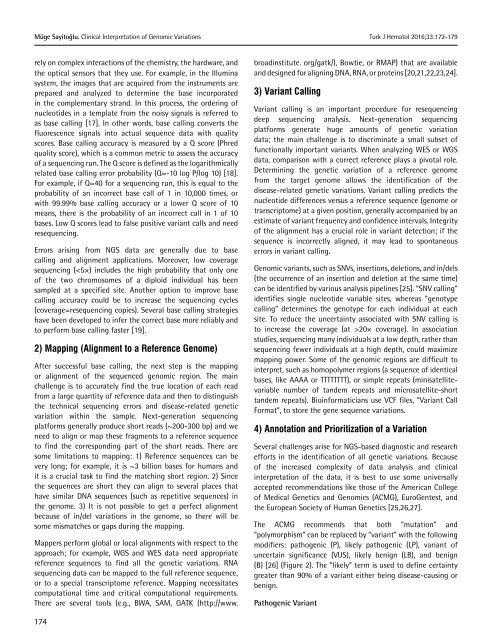Turkish Journal of Hematology Volume: 33 - Issue: 3
Create successful ePaper yourself
Turn your PDF publications into a flip-book with our unique Google optimized e-Paper software.
Müge Sayitoğlu. Clinical Interpretation <strong>of</strong> Genomic Variations<br />
Turk J Hematol 2016;<strong>33</strong>:172-179<br />
rely on complex interactions <strong>of</strong> the chemistry, the hardware, and<br />
the optical sensors that they use. For example, in the Illumina<br />
system, the images that are acquired from the instruments are<br />
prepared and analyzed to determine the base incorporated<br />
in the complementary strand. In this process, the ordering <strong>of</strong><br />
nucleotides in a template from the noisy signals is referred to<br />
as base calling [17]. In other words, base calling converts the<br />
fluorescence signals into actual sequence data with quality<br />
scores. Base calling accuracy is measured by a Q score (Phred<br />
quality score), which is a common metric to assess the accuracy<br />
<strong>of</strong> a sequencing run. The Q score is defined as the logarithmically<br />
related base calling error probability (Q=-10 log P/log 10) [18].<br />
For example, if Q=40 for a sequencing run, this is equal to the<br />
probability <strong>of</strong> an incorrect base call <strong>of</strong> 1 in 10,000 times, or<br />
with 99.99% base calling accuracy or a lower Q score <strong>of</strong> 10<br />
means, there is the probability <strong>of</strong> an incorrect call in 1 <strong>of</strong> 10<br />
bases. Low Q scores lead to false positive variant calls and need<br />
resequencing.<br />
Errors arising from NGS data are generally due to base<br />
calling and alignment applications. Moreover, low coverage<br />
sequencing (20× coverage). In association<br />
studies, sequencing many individuals at a low depth, rather than<br />
sequencing fewer individuals at a high depth, could maximize<br />
mapping power. Some <strong>of</strong> the genomic regions are difficult to<br />
interpret, such as homopolymer regions (a sequence <strong>of</strong> identical<br />
bases, like AAAA or TTTTTTTT), or simple repeats (minisatellitevariable<br />
number <strong>of</strong> tandem repeats and microsatellite-short<br />
tandem repeats). Bioinformaticians use VCF files, “Variant Call<br />
Format”, to store the gene sequence variations.<br />
4) Annotation and Prioritization <strong>of</strong> a Variation<br />
Several challenges arise for NGS-based diagnostic and research<br />
efforts in the identification <strong>of</strong> all genetic variations. Because<br />
<strong>of</strong> the increased complexity <strong>of</strong> data analysis and clinical<br />
interpretation <strong>of</strong> the data, it is best to use some universally<br />
accepted recommendations like those <strong>of</strong> the American College<br />
<strong>of</strong> Medical Genetics and Genomics (ACMG), EuroGentest, and<br />
the European Society <strong>of</strong> Human Genetics [25,26,27].<br />
The ACMG recommends that both “mutation” and<br />
“polymorphism” can be replaced by “variant” with the following<br />
modifiers: pathogenic (P), likely pathogenic (LP), variant <strong>of</strong><br />
uncertain significance (VUS), likely benign (LB), and benign<br />
(B) [26] (Figure 2). The “likely” term is used to define certainty<br />
greater than 90% <strong>of</strong> a variant either being disease-causing or<br />
benign.<br />
Pathogenic Variant<br />
174

















